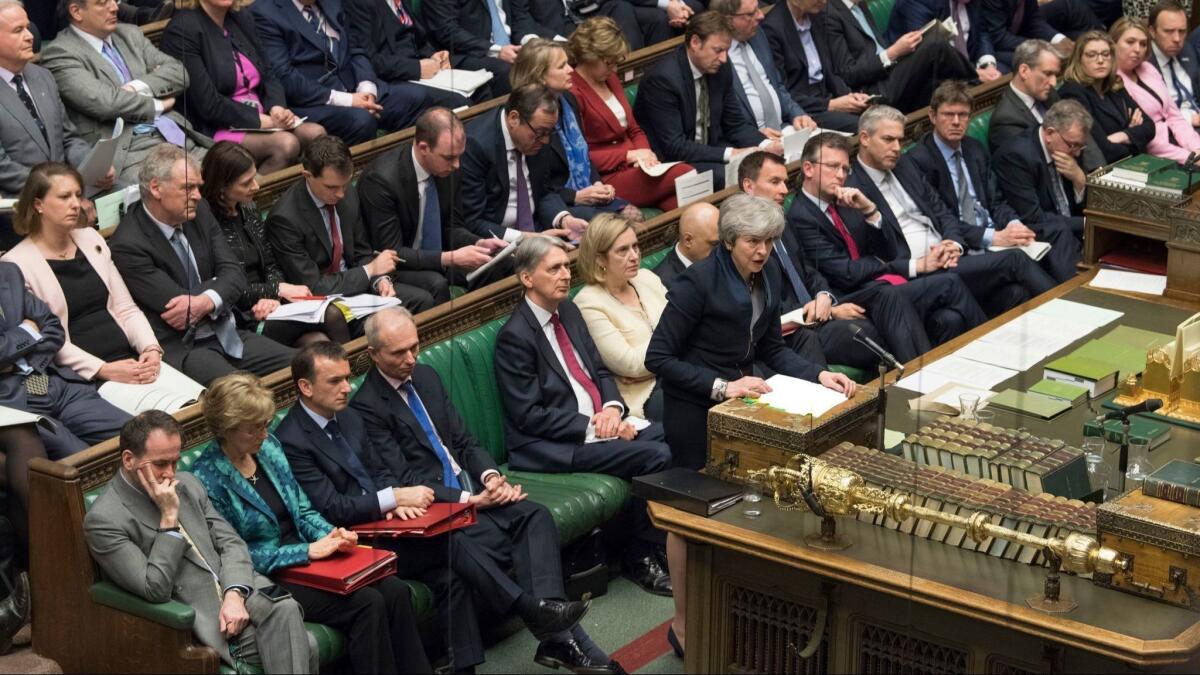A Brexit deal is better than no deal; no Brexit would be even better

- Share via
Saying she wanted to “break the logjam” in Parliament over Brexit, British Prime Minister Theresa May this week reached out to the opposition Labor Party and its leader, Jeremy Corbyn. It was a bold move that could mitigate the effect of the blunder British voters made in 2016 when they chose to take the United Kingdom out of the European Union. Ideally, it could even lead to undoing that disastrous decision.
May’s stated goal, as she reiterated in a statement Tuesday, is to “deliver the Brexit the British people voted for” — but in a form that cushions the blow to the British economy and prevents the reestablishment of a “hard border” between British-ruled Northern Ireland and the independent Republic of Ireland. The danger that Brexit would re-divide the island and reignite sectarian tensions in Northern Ireland received scant attention during the original Brexit debate, but has loomed large since.
The problem for May is that the House of Commons has refused three times to approve the deal she negotiated with the EU for a gradual and managed Brexit. Confoundingly, most members also seem to be opposed to a “no-deal” Brexit — a rupture that could occur if Parliament doesn’t approve the agreement by the current deadline of April 12. In announcing her overture to the Labor Party, May also said that she would ask the EU to extend the deadline.
A do-over would be the simplest way to deal with the problems created by the previous referendum.
The almost comic inability of Parliament to execute the electorate’s wishes in a responsible way is strong evidence that leaving the EU was an ill-conceived idea from the start. The problem is what to do now.
By opening a channel of communication to the Labor Party, May hopes to secure Parliament approval of the deal she negotiated with the EU along with a new formula to govern relations with Europe in the future. After meeting with May on Wednesday, Corbyn said the talks were “useful, but inconclusive,” adding that they would continue.
May’s willingness to engage Corbyn is encouraging, because it suggests that the Conservative prime minister will no longer have to rely on hard-line members of her own party who oppose or have qualms about the deal she negotiated with the EU. If May and Corbyn can find a basis for cooperation, it might even lead to closer trade ties between Europe and the U.K. than the agreement contemplates, such as a “customs union” between the U.K. and the EU, an idea popular with the Labor Party.
Enter the Fray: First takes on the news of the minute »
The problem is that the Labor Party is also divided on Brexit. Corbyn has sent mixed signals about his own position — including whether he would support holding a second referendum on whether Britain should leave the EU.
Such a do-over would be the simplest way to deal with the problems created by the previous referendum. Having witnessed the difficulty of disentangling the British economy from that of Europe, many voters who supported the “simple” concept of Brexit in 2016 may now realize that things aren’t that simple and change course.
After their meeting, Corbyn said he raised with May the option of “a public vote to prevent ‘no deal’ or leaving on a bad deal.” But if the voters are to be polled, why not also ask them if they support Brexit in any form? That possibility was suggested by Nicola Sturgeon, the first minister of Scotland’s government, though many these days think such a repeat of the 2016 vote is still unlikely.
Individuals who make mistakes sometimes change their minds; so do nations. A second referendum on whether to leave the EU would give sadder but wiser voters in the U.K. that opportunity.
Follow the Opinion section on Twitter @latimesopinion and Facebook
More to Read
A cure for the common opinion
Get thought-provoking perspectives with our weekly newsletter.
You may occasionally receive promotional content from the Los Angeles Times.









